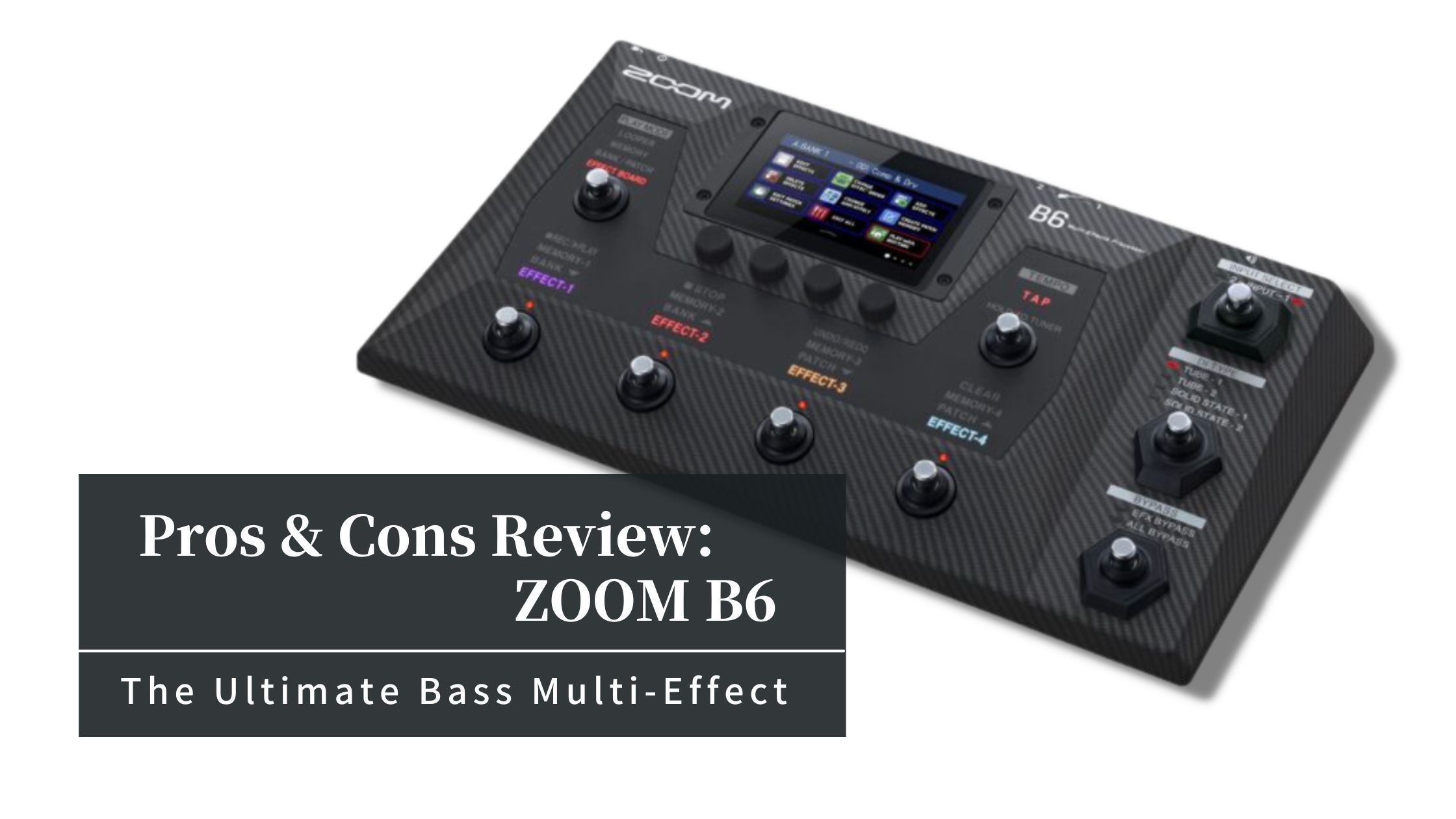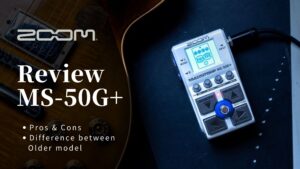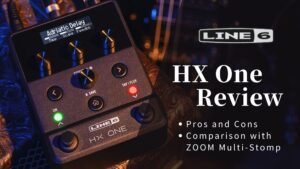ZOOM B6 is a multi-effect pedal that has been developed with the needs of bassists in mind. With a wide range of features, including bass-specific effects, DI box modeling, and touchscreen operation, it offers a comprehensive solution for bassists looking to craft their unique sound. Whether you're a beginner or a professional, the B6 is a worthy addition to your gear lineup. If you're considering upgrading your current multi-effect pedal or looking for a versatile and reliable solution, the ZOOM B6 is a top recommendation.
For those who:
● Want to complete their sound-making with a single unit.
● Desire a floor multi-effect pedal specialized for bass.
● Are considering upgrading due to dissatisfaction with ZOOM B3 or similar products.
Yosh, an ex-musical instrument store clerk (@Yosh_Guitar), explains the optimal solution for the current bass multi-effect pedal, ZOOM B6.
Pros of ZOOM B6
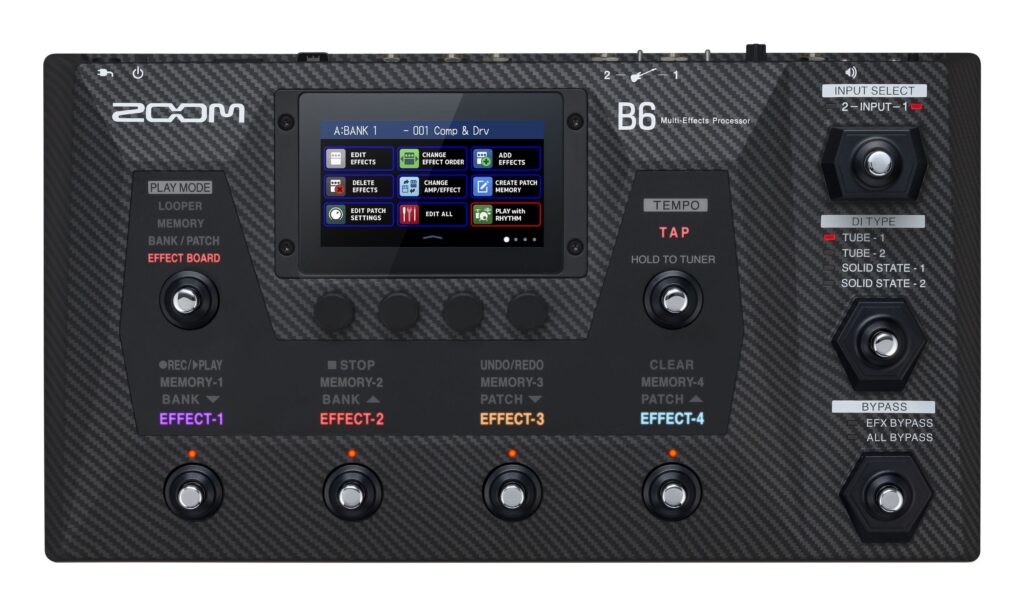

A Precious Bass-Specialized Multi-Effect
While there were several brands releasing guitar multi-effect pedals like BOSS, in recent years, there have been hardly any multi-effect pedals exclusively for bass. Other brands, perhaps to cut costs, have consolidated to support both guitar and bass, like BOSS GT-1000 and Line6 Helix. However, having fewer tonal options or having to avoid guitar effects when making a sound can be stressful. ZOOM has the G5n for guitars, and even though they had the B3n for bass, it was mid-range with limited features. The newly introduced B6 is truly the long-awaited flagship multi-effect pedal for bass.
Use Up to 6 of the 119 Types of Effects
It boasts several bass-specific tones not found in other multi-processors. As long as the built-in DSP’s processing capability allows, up to 6 can be used simultaneously in one patch. The effects include:
- Dynamics: 10 types
- Filters: 14 types
- Distortions: 13 types
- Preamps: 22 types
- Cabinets: 12 types
- Modulations: 17 types
- SFX: 7 types
- Delays: 7 types
- Reverbs: 8 types
- Pedals: 6 types
- Send Returns: 3 types
- IR: 36 types (third-party data can also be used)
The most intriguing part is the preamp section. It includes pedal types like SansAmp, MXR BASS DI+, Darkglass B7K, and standard amps like Ampeg, Fender, SWR, Aguilar, EBS, Markbass, studio types like AVALON U5, and even ultra-modern ZOOM originals suitable for djent. It’s safe to say there’s no genre it can’t handle. All effects list is below in this article.
Four Play Modes
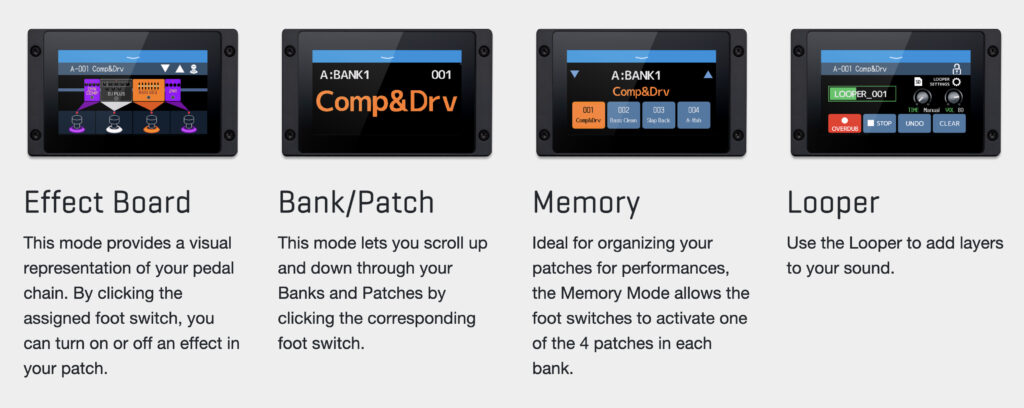
Switching effects with the footswitch comes in four modes. For bass, it’s common to create a basic sound and then, for example, turn on a booster only during solos or apply ambient effects during interludes. The EFFECT BOARD mode, which allows individual on/off of effects within a patch, is likely to be user-friendly.
Touch Screen Operation
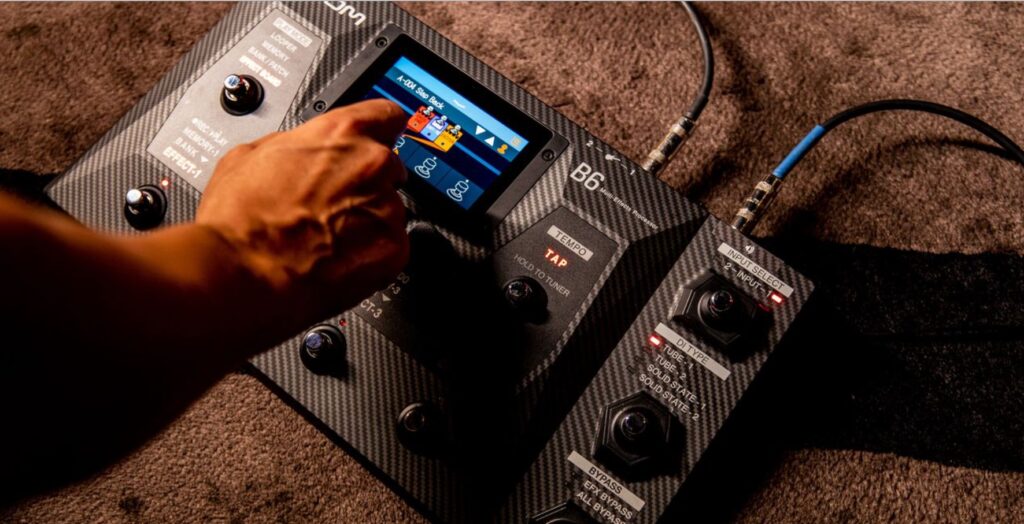
Because of its multifunctionality, many might find operating it with switches, buttons, and knobs cumbersome. B6, like the guitar versions G6 and G11, is equipped with a touchscreen, allowing sound-making with smart device like operability, such as drag & drop and swiping.
Four Types of DI Box Modeling
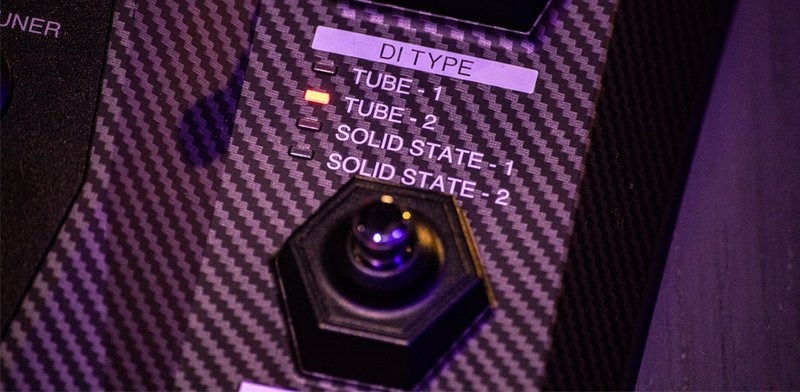
This can be said to be a bass-specific feature. The DI out can be selected from four types of modeling:
- TUBE 1: Abundant harmonics and a thick low range.
- TUBE 2: Clear attack and tight low range.
- SOLID STATE 1: Moderate compression and sharp tone.
- SOLID STATE 2: Minimal distortion and clear tone.
This feature might seem unnecessary to some, but it can be seen as a function aimed at intermediate to advanced users or professionals. It suggests confidence in the sound quality suitable for professional settings. The DI section affects both the output (line/phone) and XLR and can be turned off. When using the XLR out at a club for amateurs, it’s a good idea to consult with the PA person.
Two Input Channels with Footswitch Switching
There are two inputs. Different basses can be connected and switched with a footswitch. Each has an impedance (1MΩ/10MΩ) switch, and the output volume can be set individually, allowing for consistent volume when switching between 4-string/5-string, passive/active, or piezo pickups. This is also a feature for advanced users.
Various Other Features
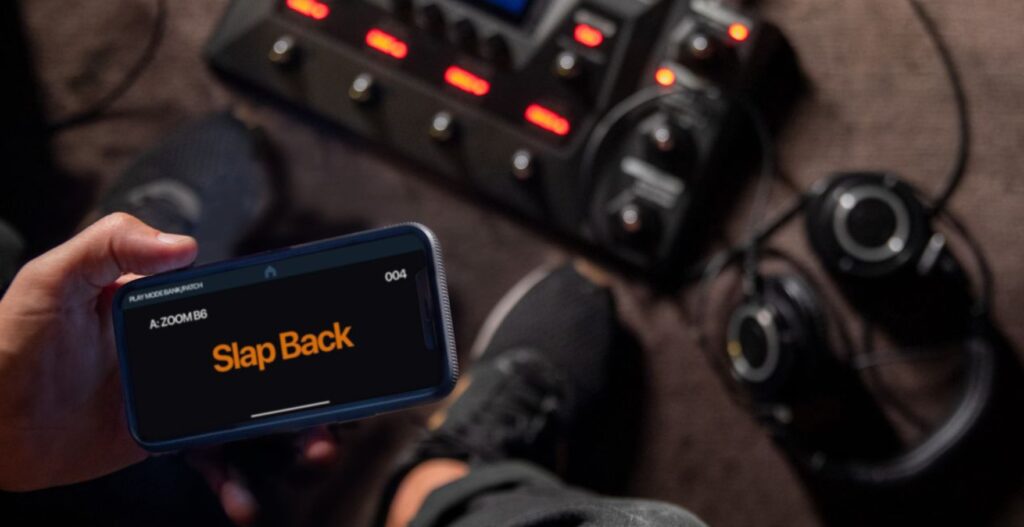
Other features include:
- Send/Return terminals
- Looper
- Rhythm machine
- USB audio interface function
- Smart device app operation
Even if there’s an indispensable effect that defines one’s identity, it can be combined with the effects in B6 using the send/return terminal. The looper recording time is 45 seconds in stereo (90 seconds in mono). With an SD card, it can be extended to a maximum of 2 hours. Phrases can be saved, and external WAV files can be played back. The rhythm machine can be used alone or in conjunction with the looper. It features 68 types, and of course, tempo and volume can be adjusted. By connecting with a USB cable to a PC or iOS device, it can be used as a 2in/2out audio interface. It also comes with a free download license for the DAW software Cubase LE, a bonus for bassists looking to start DTM. The sound crafted in B6 can be recorded directly, making it convenient for social media performances, composing, and demo creation. By connecting a separately sold adapter (BTA-1), it can be remotely operated with an app via Bluetooth connection with an iPhone/iPad.
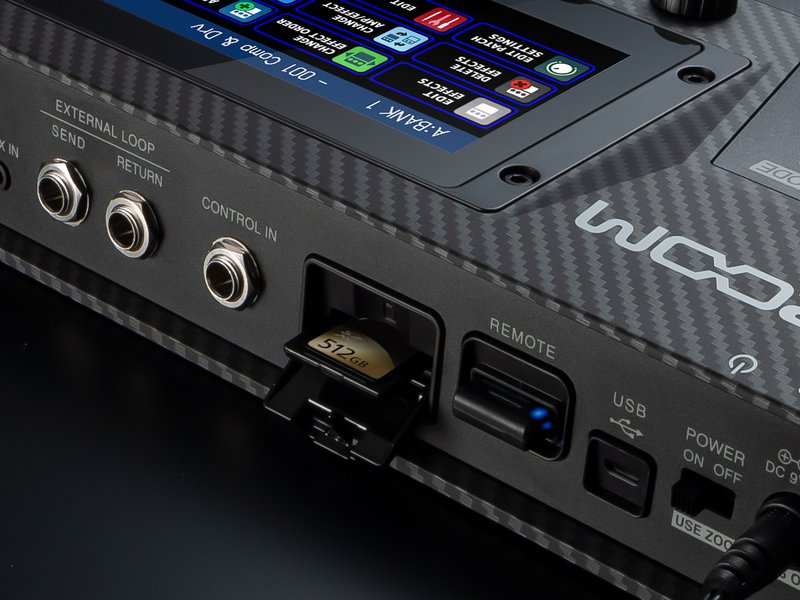
Cons of ZOOM B6
The Size is Somewhat Large
Having many foot switches allows for versatile patch switching. However, this comes at the cost of the unit’s size. If used in combination with other pedals, the board is likely to become quite large.
Price Point
For some users, especially beginners or those on a tight budget, the ZOOM B6 might be considered a bit pricey compared to other options in the market.
Effects List
DYNAMICS
- SlowATTCK: An effect that does not produce an attack sound like volume playing.
- ZNR: ZOOM’s original noise reduction. It can be applied strongly.
- OptComp: Modeling of optical compressor.
- BlackOpt: Modeling of Demeter COMP-1 Compulator.
- LMT-76: Modeling of UREI 1176LN.
- 160 Comp: Modeling of dbx 160A.
- DualComp: Allows the setting of the compressor for both low and high frequencies.
- MB Comp: Modeling of EBS MultiComp (MODE: MB).
- DYN Comp: Modeling of MXR Dyna Comp.
- Glam Comp: Compressor with mixable original sound.
FILTER
- SeqFLTR: Modeling of Z.Vex Seek Wah.
- EG FLTR: Two frequency bands can be set for the filter, and each can be switched with a footswitch.
- Exciter: Exciter.
- BassA-Wah: Auto-wah with mixable original sound.
- Z Tron: Modeling of Electro-Harmonix Q-Tron’s LP mode.
- A-Filter: Intense filter.
- Bass Cry: Talking modulator.
- BassGEQ: 7-band graphic equalizer with 50/120/400/500/800/4.5k/10k.
- St Ba GEQ: 7-band stereo graphic equalizer with 50/120/400/500/800/4.5k/10k.
- BassPEQ: Parametric equalizer.
- Splitter: Splits high and low frequencies and allows free mixing.
- Low EQ: Filter that allows selection between shelving and high-pass.
- High EQ: Filter that allows selection between shelving and low-pass.
- EnvFilter: Modeling of MXR envelope filter.
DRIVE
- EP Stomp: Modeling of the preamp section of Maestro Echoplex.
- RC Boost: Modeling of Xotic RC Booster.
- NYC Muff: Modeling of Electro-Harmonix Big Muff Pi.
- TS+Boost: Tube Screamer + Booster.
- Squeak: Modeling of ProCo RAT.
- Bass ODB: Modeling of BOSS ODB-3.
- BassTsDRV: Effect modeled after Ibanez TS808.
- Dark OD: Modeling of Darkglass Electronics Microtubes B3K.
- BlueB BOD: Modeling of MAD PROFESSOR Blueberry Bass Overdrive.
- VooDoo-B: Modeling of ROGER MAYER VOODOO-BASS.
- BaFzSmile: Modeling of FUZZ FACE. Added a parameter to adjust the volume balance between the original sound and distortion.
- BassMetal: Modeling of BOSS Metal Zone.
- BassOctFZ: Fuzz with added upper octave.
PREAMP
- BassDRV: Modeling of SansAmp BASS DRIVER DI.
- D.I. Plus: Modeling of MXR Bass D.I.+.
- Drak Pre: Modeling of Darkglass Electronics Microtubes B7K.
- Bass BB: Modeling of Xotic Bass BB Preamp.
- DI-5: Modeling of AVALON DESIGN U5.
- Bass Pre: 3-band EQ preamp.
- Pre1073: Modeling sound of Neve 1073 preamp.
- SoldPre: Modeling of SSL (Solid State Logic) preamp.
- Clear DRV: ZOOM original clear distortion obtained when mixing the original sound without phase interference.
- SpLoPre: ZOOM original preamp that provides ultra-low frequencies.
- DjentPre: ZOOM original preamp that combines undistorted low-end with heavily distorted high-end.
- AMPG SVT: Modeling of Ampeg SVT.
- BMAN100: Modeling of Fender Bassman 100.
- SMR400: Modeling of SWR SM-400.
- AG 750: Modeling of Aguilar DB 750.
- TE400SMX: Modeling of Trace Elliot AH400SMX.
- AC 370: Modeling of Acoustic 370.
- Mini MkB: Modeling of Markbass MINIMARK 802.
- EBH360: Modeling of EBS HD360.
- FlipTop: Modeling of Ampeg B-15N.
- SUN CB: Modeling of sunn.
- Monotone: Modeling of Polytone.
CABINET
- SVT8x10: Cabinet of Ampeg SVT-810E.
- SVT4x10TW: Cabinet of Ampeg SVT-410HLF.
- FD-B4x12: Cabinet of Fender Bassman 100.
- SMR4x10TW: Cabinet of SWR GOLIATH.
- AG4x10TW: Cabinet of Aguilar GS410.
- TE4x10: Cabinet of TRACE ELLIOT 1048.
- AC1x18: Cabinet of Acoustic 301.
- MkB2x8TW: Cabinet of Markbass MINIMARK 802.
- EB4x10TW: Cabinet of EBS ProLine 410.
- AM1x15: Cabinet of Ampeg B-15N.
- SN2x15: Cabinet of sunn.
- MT1x15: Cabinet of Polytone.
MODULATION
- Tremolo: Tremolo.
- Phaser: Phaser.
- TheVibe: Vibrato.
- PitchSHFT: Pitch shifter.
- HPS: Harmonizer, intelligence pitch shifter.
- Kick FLNG: Flanger.
- CloneCho: Modeling of Electro-Harmonix SmallClone.
- SuperCho: Modeling of BOSS SUPER CHORUS CH-1.
- CoronaTri: Modeling of tc electronic CORONA Tri-Chorus.
- BassStCho: Stereo chorus for bass.
- BaVinFLNG: Modeling of MXR M-117R.
- Ba Octave: Octaver.
- Ba AnaOct: Analog-style octaver.
- Ba Detune: Detune.
- BaMinPitch: Monophonic pitch shifter.
- BaPlShift: Polyphonic pitch shifter.
- BassPhase: Phaser.
SFX
- Bomber: ZOOM’s familiar effect that produces an explosion sound.
- LoopRoll: Effect that can hold a performance with a footswitch.
- BaStdSyn: Bass synth.
- BaSynTlk: Talking modulator.
- Z-Syn: Bass synth sounds like an analog synth.
DELAY
- Delay: Long delay up to 4000ms.
- AnalogDly: Analog-style long delay up to 4000ms.
- TapeEcho: Tape echo style.
- ReverseDL: Reverse delay.
- ModDelay: Modulation delay.
- Hold DLY: Effect similar to the HOLD function of BOSS DD-7.
- Dual DLY: Effect like two delays in series.
REVERB
- Air: Reverb like room resonance.
- Room: Room reverb.
- BrghtRoom: Bright room reverb.
- Hall: Hall reverb.
- BrghtHall: Bright hall reverb.
- HD Hall: Dense reverb.
- Spring: Spring reverb.
- Plate: Plate reverb.
PEDAL
Pedals that can be operated by connecting a separately sold expression pedal.
- PDL Vol: Volume pedal.
- BassWah: Wah.
- PDL Reso: Analog synth filter style.
- B_a PDL: Pit pedal pitch shifter.
- Ba PDLMnP: Monophonic pedal pitch shifter.
- Output VP: Volume pedal for master volume.
SND-RTN
- FxLoop: Send/return.
- Send: Send terminal.
- Return: Return terminal.
IR
IR stands for Impulse Response. The alphabet represents the common name of the modeling source. The numbers like 〇x〇 represent the number of speakers (first number) and the size of the speaker (second number). Those with “TW” have a tweeter. For example, 4x10TW represents 4 10-inch speakers + a tweeter. Below, each one is pre-installed with on-mic, on-mic + tweeter mix, and room mic. Third-party products can also be used by reading them with an SD card.
- SVT8x10: Ampeg SVT
- SVT4x10TW: Ampeg SVT
- FD-B4x12: Fender Bassman100
- SMR4x10TW: SWR Goliath
- AG4x10TW: Aguilar GS410
- TE4x10: Trace Elliot 1048
- AC1x18: Acoustic 301
- MkB2x8TW: Markbass MINIMARK802
- EB4x10TW: EBS EBH360
- AM1x15: Ampeg B-15N
- SN2x15: Sunn CB
- MT1x15: Polytone
Comparison with B3n
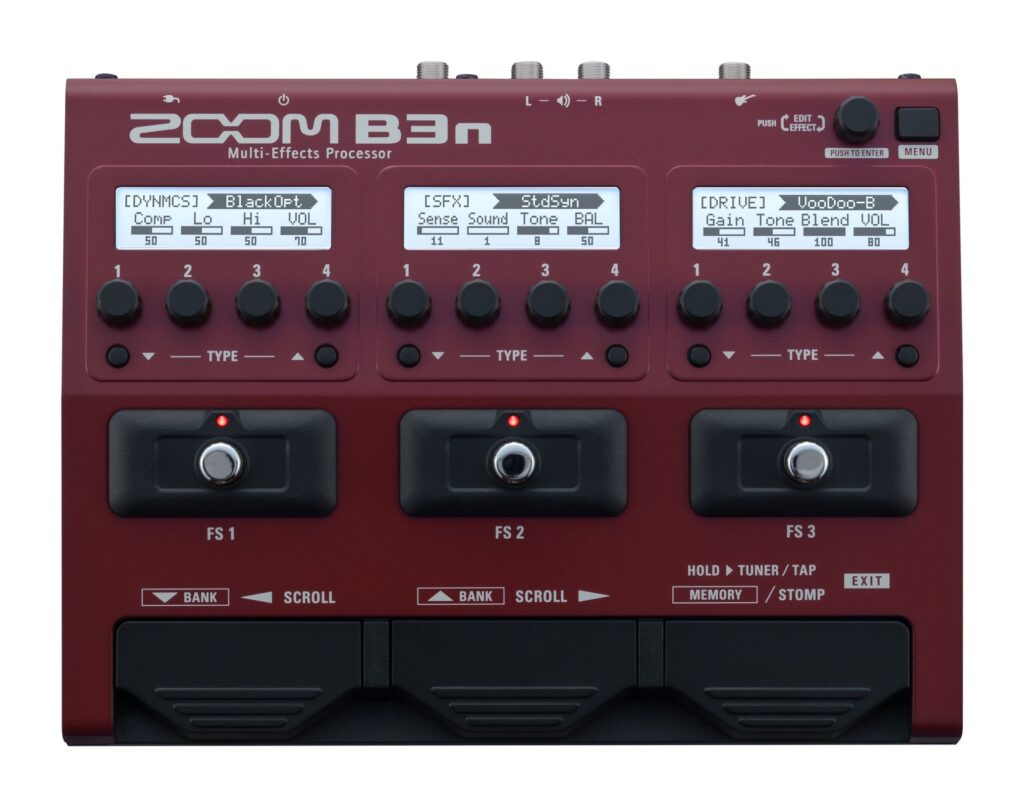
| Specification | B6 | B3n |
|---|---|---|
| Market Price | $499.99 | $229.99 |
| Footswitch | 9 | 6 |
| Number of Effects | 119 | 70 |
| Simultaneous Effects | 6 | 7 |
| Patch User Area | 240 | 150 |
| Sampling Frequency | 88.2 kHz | 44.1 kHz |
| Signal Processing | 32-bit | 32-bit |
| Frequency Response | 20 Hz 〜 40 kHz | 20 Hz~20 kHz |
| Display | 4.3-inch color | Dot matrix x3 |
| Input Terminals | Input x2, Return, AUX IN | Input, AUX IN |
| Output Terminals | Amp/Line (Headphone), XLR, Send | Out L (Amp/Headphone), Out R |
| Control Input | Expression Pedal | Expression Pedal |
| USB | USB Audio Interface Function | Used for Update |
| Rhythm/Looper | 68 types/Max mono 90 sec | 68 types/Max mono 80 sec |
| Power | DC9V/Center minus/500mA (Zoom AD-16) | DC9V/Center minus/500mA (Zoom AD-16) |
| Size | 228 mm (D) x 418 mm (W) x 65 mm (H) | 181 (D) x 234 (W) x 58 (H) mm |
| Weight | 1890 g | 1280g |
When comparing the specs with the previous model B3n, the B6 is clearly superior in terms of features. The B3n was released in 2017 and is priced at less than half the B6, so it’s natural that the B6 has better features. B6’s main advantage is its sound quality. With a sampling frequency twice the norm at 88.2kHz and a frequency response extending to 40 kHz, along with a redesigned analog circuit, the results are clearer sound, a wider range, and less change in bypass sound. This makes it sound more lifelike compared to traditional digital effects. Many on Social Media have reported similar impressions. Additionally, the B6 offers a richer variety of effects, especially preamps. Also, the footswitch operation has improved, allowing for up to 4 effects to be turned on/off in the B6 compared to 3 in the B3n. Sound making is also smoother with the B6.
Considering the B6’s price of just around $500, it might seem expensive compared to the B3n. However, when compared to the BOSS GT-1000, which is priced over $1,000 and has fewer bass effects, or when considering the cost of assembling a board with individual effects, power supplies, and patch cables, the B6 might actually be more cost-effective. After all, one of the merits of a multi-effect pedal is reducing trouble, easily adding effects and the convenience of an all-in-one solution. If the goal is to complete everything with one device, the ZOOM B6 is currently the most balanced equipment.
The B6 is recommended for those who:
- Want to complete their bass sound creation with just this one device.
- Desire to combine and use their favorite effectors.
- Don’t want to worry about equipment anymore and seek professional-grade sound quality.
- Want to record a sound similar to mic recording using IR, directly through a line.
- Are looking for a USB audio interface function for PC recording.
- Want to consolidate home practice features like headphones and rhythm machines into just this one device.
The B3n is recommended for those who:
- Prioritize a lower cost.
- Prefer a lightweight size for easy portability.
- Need to output in two systems, L and R.
- Satisfied with average sound quality.
- Don’t need the USB audio interface function.
- Don’t need the effect loop’s send/return terminals.

